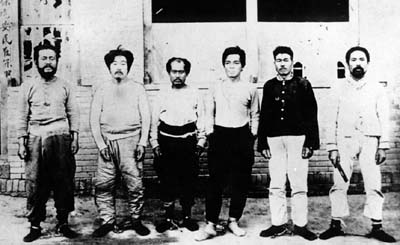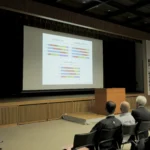By Ruth Reiner
Well hello there. Sorry I’m a bit behind schedule. Actually my excuse for keeping you waiting in such a critical time in our hero’s life is kind of a family issue. I was a very lucky child to have the opportunity to have my dad over for 10 days, and we did a kind of daughter and father trip here in Japan. So anyway he went back to Israel two days ago and I am back with my book, my computer, and you.
Just as a reminder we left off last time as our hero was being led to execution in his underwear… You know my dad always said that consistency is an important quality. No doubt about consistency with our hero here:

“It was decided that they be shot on the spot, and they were led to the place of execution. Onisaburo, bold and dauntless, composed three farewell poems for himself, and also composed poems for the others.” (ch 26)
Isn’t that just Onisaburo’s incredible personality – -true artist I say!
Here we are told that Onisaburo “was most afraid that the souls of the people shot to death are liable to be scattered by the shock, and therefore he wanted them all to concentrate their minds as one on him. By doing so they would be able to safely ascend to heaven.” (ch 26)
This is a very powerful statement I thought, and so I turned around in my office chair to ask Mr. Tanaka (who helps me with great devotion on all the big theological question marks that arise in my readings here), and asked for a clarification of this last point.
I was finding it unclear why Onisaburo would emphasize concentration on him before they all die?! The question at first seemed quite trivial to Mr. Tanaka: “Well it is quite simple”, he answered.
Simple it may have been to him but I wanted to truly understand it in my world of perceptions. He explained it on two levels:
On one level: clarity of mind consciousness and concentration at the time of death, is the key to an easy transition into the stages after death. The other point was that Onisaburo himself had special powers, as a spiritual leader, as a messenger of god to help bring the people to the heavens. I found the first idea he stated quite similar to The Tibetan “Book of the Dead”, the idea of clearness of concentration in the process of dying, not letting fear take over pulling you with greed of attachment to this life ect… Well in Judaism too I guess the idea of calling the name of god out before death has the same goal of clarity and unification of the soul with divine aspirations.
Anyway back to our story:
While he was “…waiting for the bullet to pierce his breast…the execution was called off, and the soldiers marched them away to the Tongliano government office and through them into a cell. They had come back from the verge of death.” (ch 26)
You know, when we watch a movie and the most critical moment comes, and we look at our watches, and we see there is still another hour to our movie! It is impossible for our hero to die now! He still has one more hour to be on screen!!! This is just about the same story here: what would I do if it would all end today? What will you read next week!?
So yah indeed a narrow escape it was for Onisaburo from this one on one match with death. Here there are two factors that came together: first, there seemed to have been a failure with the machine guns. It is said that the trigger was actually pulled! The second factor was that a clerk from the Japanese consulate came to the scene, demanding their release in order to avoid an international dispute ”which would follow the execution of such a well-known Japanese.” (ch 26)
After long negotiations, they finally ended up in the detention house in Osaka…
OK, at this point in the book (and we have just entered the 27th chapter), we find an interesting presentation of the public opinion in japan in those days concerning Onisaburo’s return from his “Mongolian Expedition”. Mr. Kyotaro Deguchi (the writer of the book, and the grandson of Onisaburo Deguchi), gives us a general idea of the outcomes, and debates of the great voyage. We are presented here with a list of headlines given by the media to this voyage, showing us what a public impact Onisaburo had in Japan. The media had in general given the idea that this was all an action of megalomania. On the other hand Onisaburo was welcomed by admiring crowds upon his return to Japan.
Chapter 28 starts with an interesting solution to the question of Onisaburo’s personality, megalomania or not? we are told that about two and a half years after Onisaburo’s return from Mongolia, he actually underwent a psychiatric examination, a process that took some nine months consisting of seven examinations. It is said that finally on December of 1926, Dr. Sugita of Tokyo Imperial University announced the result : “I conclude that Onisaburo Deguchi is not suffering from megalomania or any similar psychological disorder”. (ch 28)
On November 1, 1924, Onisaburo was finally released on bail after ninety-eight days of imprisonment all together, and returned to Oomoto after ten months of absence, making Kameoka his base. The period that began at that time is considered as: “the dawn of the second ‘Golden Age’ of Oomoto” (ch 28).
On this optimistic note I would like to end this item.



